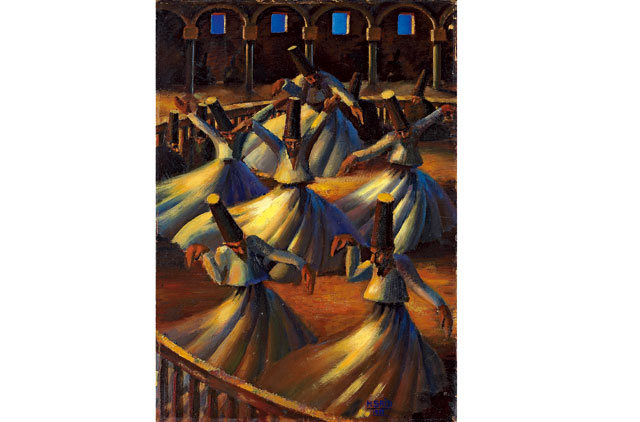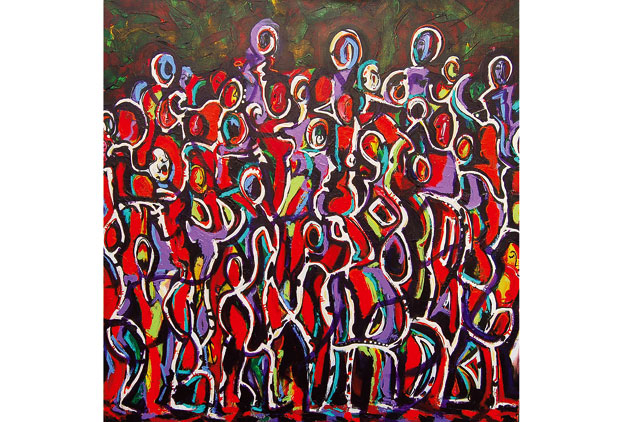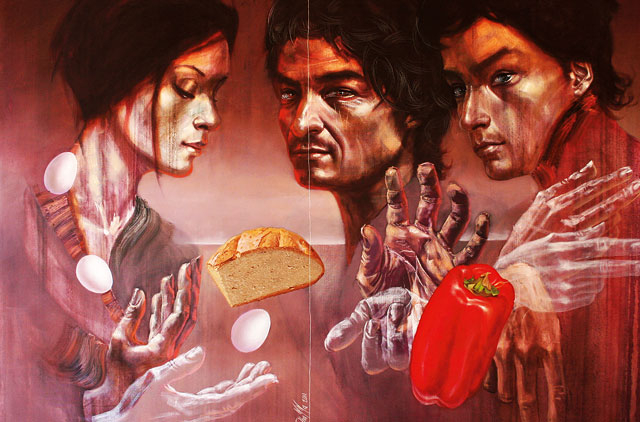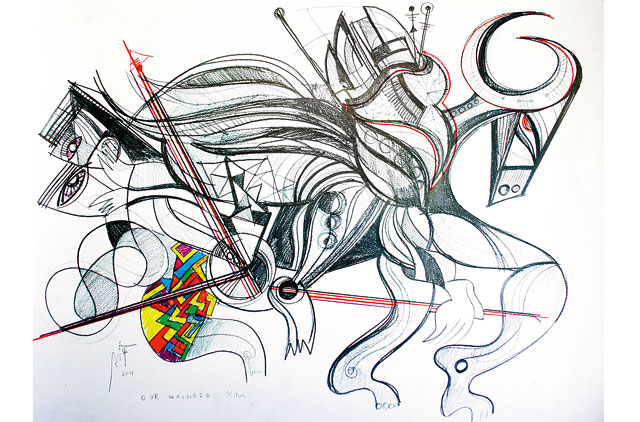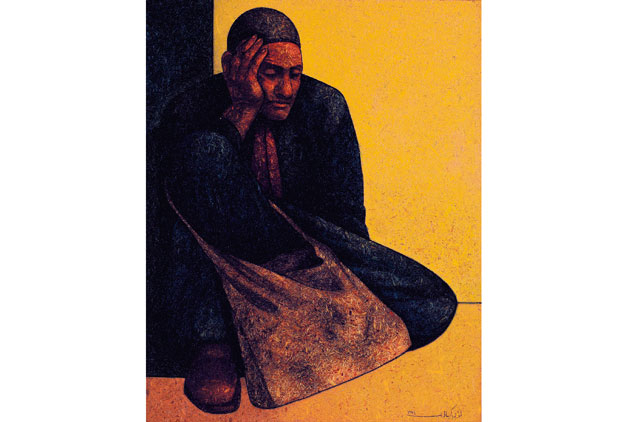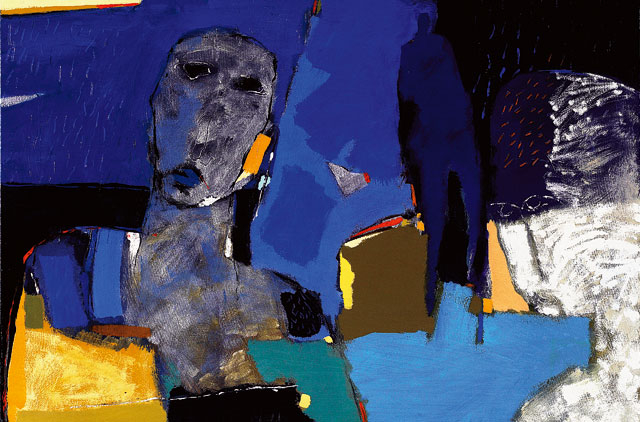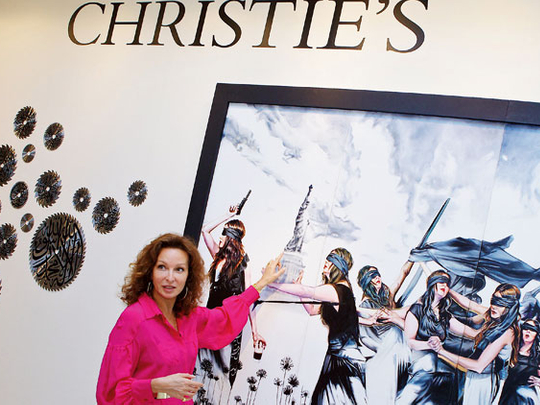
The patterns are intricate and etched onto a dome of copper, perched precariously above a miniature dove. Titled Message/Messenger and created by Saudi artist Abdulnasser Gharem, the art installation sold for just over $842,500 (Dh3.09 million) - more than eight times its original estimate - at a Christie's auction in Dubai last year. The sale was proof that art from the Middle East had truly arrived on the international scene.
With the current creative and commercial buzz around the region's art scene, collectors from the region and around the world are descending on Dubai to snap up pieces from young and, until recently, relatively unknown names from the Middle East. Artists such as Ahmed Askalany from Egypt and Zena Assi from Lebanon, to name just a few, are suddenly finding their work selling for millions of dirhams at international auctions.
The number of art galleries and art fairs in the region is expanding with serious and moneyed art collectors as well as curators looking for exclusive pieces to include in their collections and galleries.
Collectors and curators from the Middle East have begun to figure in international power lists too, showing just how much clout the region now boasts. Turkish curator Vasif Kortun, who curated the UAE pavilion at the 54 Venice Biennale in 2011, ranked an impressive 82nd place in Art Review's Power 100 list last November. It's the first time anyone from the Middle East has been recognised.
"Interest in the region's art has definitely grown,'' says Isabelle de la Bruyere, Christie's director for the Middle East. When the international auction house opened its regional offices in Dubai in 2005, it began with a conservative projection estimating sales of $30 million (Dh110 million) between 2006 and 2009. However, the group was in for a pleasant surprise when it posted business worth $63 million (Dh231 million) in just two years.
Beyond expectations
Many artists today are able to sell at prices far higher than their pre-sale estimates, Isabelle says. Mahmoud Said's The Whirling Dervishes set a world record when it was sold in 2010 for $2.54 million (Dh9.33 million), the highest price ever paid for a Middle Eastern painting. It far surpassed it's pre-sale estimate of $300,000 (Dh1,101,930) to $400,000 (Dh1,469,240).
More recently, in last October's part I auction held in Dubai, Christie's sold $7.3 million (Dh26.8 million) of modern and contemporary Arab, Iranian and Turkish art.
At Christie's part II auction of modern and contemporary Arab, Iranian and Turkish art, the sale of work by artists from 15 Middle Eastern countries totalled Dh8.7 million, higher than the pre-sale estimate of Dh7.2 million.
At the same auction, the Tree Trunk series by contemporary Iranian artist Sohrab Sepehri sold for $662,500 (Dh2,433,428) to a private collector - a record for the artist. Syrian artist Louay Kayyali also broke his own record with her piece Fisherman in Arward selling for $194,500 (Dh714,417).
Since the value of art has appreciated so well over the past few years, many people who had invested in real estate and gold, have started looking at art as a safe area to invest. The fact that there are pieces starting at reasonable prices is also attracting first-time art buyers. "The part II sale was a way for new collectors to buy great works by emerging artists with estimates around $1,500,'' says Isabelle. And there are plenty of upcoming artists with enormous potential, she says.
Salwa Zeidan, celebrated Lebanese artist and curator of her eponymous Salwa Zeidan Art Gallery in Abu Dhabi, has high praise for contemporary Emirati artist Hassan Sharif. "He is well recognised and many museums around the world are purchasing his art. Eventually his prices will go up because he is well known in the art circles.'' His works reflect the negative aspects of consumerism.
"Fatima Al Mazroui, a young Emirati artist, is another to watch out for,'' she adds. Many of her works are a reflection of UAE's historic past. "Her prices have risen in a very short time compared to other artists due to high demand for her work. And Abdul Qader Al Rais is the celebrated Emirati artist whose stocks have risen steadily over the years," Salwa says. His monumental and colourful work often includes elements of calligraphy.
Going global
"Art collectors that specialise in genres or regions used to be the norm, and it certainly is the way most collectors start buying," says Isabelle. "But we have started to see the market for modern and contemporary Middle Eastern art become more regionalised and subsequently internationalised.'
"So we now see buyers from across the Middle East buying art from neighbouring countries. For example Lebanese buying Syrian art, Iranians buying Egyptian art, Emiratis buying Iranian art... But we also see increasing international participation in our sales in Dubai," she says. "On average, 30 per cent of the works sold now go to collectors globally. The market for modern and contemporary Middle Eastern art has become more internationalised with a far deeper base of buyers, which is important for the long term sustainability of the market.
"The cultural landscape of the Middle East is changing. In Dubai, where there were only five art galleries a decade ago, we now have 85. New museums and galleries are being built in the region. There are art fairs in Beirut, Morocco, Dubai and Abu Dhabi. People of this region are investing in art. Since 2006 when we offered the world the first international platform for art in this region, we have grown a lot. We now have a 20 per cent growth rate each year and have set 340 world records at auctions to date in this region. In Dubai we have sold $220 million worth of objects so far at the auctions and we now have two sales seasons twice each year," says Isabelle.
Building momentum
Amel Makkawi, curator of Art Sawa gallery, believes the trend to purchase pieces by regional artists has been gathering steam in the last few years. Dubai, being at the epicentre of this growing creative energy, showcases this trend. Ten of the 35 galleries represented at Art Dubai this year were from the emirate.
"I believe this is happening because three factors have finally come together - artists, promoters and the market," Amel says.
"The artists first matured technically and conceptually as well as in their process of producing contemporary art, and this is reflected in their works, and in the sale and marketing force. The promoters of Middle Eastern art - art galleries, curators, art magazines, auction houses, museums and fairs - have recognised the huge potential in artists' development and have strengthened professionally in order to highlight it.
"Also, the collectors have found that the prices are still affordable for such quality and have realised they can acquire a collection with a smaller budget."
Salwa agrees with Amel. "Art in this region has a strong market because of its natural growth. So much has been happening in the region leaving the artists with a lot to express," she says. "Also, artists have matured in their technique and in their abilities to express. People around the world are curious to know who we are through our art. Good Middle Eastern art is still low-priced compared to art from the rest of the world and, therefore, I see a great potential for growth as there is demand for it among regional and international art collectors.''
Bashar Al Shroogi, curator of the Dubai International Financial Centre-based Cuadro, feels this boom has not been sudden, rather, it has been a natural evolution. "The regional art market is maturing, which has brought an increased level of awareness and exposure, both local and global,'' he says.
The deciding factor
With so many talented artists, gorgeous pieces and different price points, it can be difficult to know what to buy. "We never recommend people buy art as an investment," says Isabelle. "We always encourage collectors to buy what they love and, if over time, the value increases, then that's an added bonus.''
"Our understanding of bankable artists comes from researching the works available,'' says Amel. "We have two categories of artists. The masters are well established with their works recognised by museums, institutions, reputed collectors and an audience that follows their success. They have been part of the art movement, or are a slice of the art history.
"Then we have upcoming artists; a young generation of artists full of potential and enormous talent with works that are priced lower. If you are looking to purchase good art of this region I would advise you to go first with what you like simply because you have truly and sincerely to enjoy your acquisition.
"The second step would be to research the work, its technique and meaning. You need to learn about the artist, his or her background, commitment to art and to art dealers."
Good research will ensure you have a better chance of bidding on the next Damien Hirst of the Middle East.
Amel Makkawi’s top six artists to keep an eye out for:
1. Ahmed Askalany, Egyptian, sculptor
2. Marwa Adel, Egyptian, photographer
3. Zena Assi, Lebanese, painter
4. Wael Darwesh, Egyptian, painter
5. Sumayyah Al Suwaidi, Emirati, digital artist
6. Hend El Falafly, Egyptian, painter and engravings
"I can't guarantee that all their works will go up to millions but they have a professional trajectory and career and details about them can be found on our website: www.artsawa.com"
- Amel Makkawi


